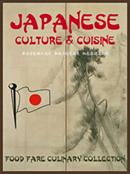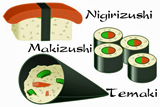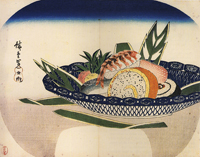|
Contents:
More:
E-book edition of "Japanese Culture & Cuisine" >
|
Sushi
Sushi is perhaps the most well-known Japanese dish in western culture, yet the components are quite simple. The most common form of sushi is vinegar-seasoned rice (shari) mixed with other various ingredients (neta). The combinations are seemingly endless, although the most typical includes raw seafood rolled in rice-coated seaweed squares. The earliest reference to sushi can be found in the Yoro Code (718), which describes governing principles during the Nara period (710-794 AD). The code mentions taxation of a food product known as zakonosushi. Sushi appeared in China (then known as nare-zushi) before finding its way to Japan. Fish eaten with rice (namanare) was a favorite combination, which was nothing more than semi-raw fish wrapped in sticky rice. A third type of sushi was also developed during the Edo period, known as haya-zushi, when rice was mixed with vinegar, fish, vegetables and other dried foods. Street stalls offering prepared sushi became popular in the late 1800s, also when nigiri-zushi came into being. Other common types of sushi include:
Aside from nori, sushi ingredients can also be wrapped in rice paper, thinly-sliced cucumber, sweet omelet (nori-tama) or a skin made from tofu and soybeans (yuba), among others. Western variations of sushi are many. Each state or region seems to have their own specialty roll, with California leading the pack. Others include:
The following recipe is a variation of the California Roll: Easy Sushi Rolls
In a medium-sized saucepan, bring 1-1/3 cups water to a boil. Add the rice; stir. Reduce heat, cover and simmer for about twenty minutes. Allow to cool before handling. In a small bowl, mix together the rice vinegar, sugar and salt. Blend the mixture into rice. Meanwhile, preheat oven to 300-degrees F. Heat nori on a baking sheet for one or two minutes, just until warmed. Center one sheet of nori on a bamboo sushi mat. Wet hands and spread rice on nori sheet, pressing into a thin layer. Arrange 1/4 of the cucumber, ginger, avocado and imitation crabmeat in a line down the center of rice. Lift one end of the mat, rolling over the ingredients and pressing gently. Roll it forward to make a complete roll. Repeat with remaining ingredients. Cut each roll into four to six slices using a wet, sharp knife. Note: Substitute bamboo mat with a clean dish towel to roll sushi.
Bamboo mats for making sushi can be found at most Asian grocers. Some stores even offer complete sushi-making kits. A simple yet delicious recipe for sushi rice: Sushi Rice
Place rice in a deep bowl. Fill with cold water; rub rice together with hands until water turns milky white. Pour off water, being careful to keep rice in the bowl. Repeat process three or four times until water is clear. Drain the rice in a fine strainer, then place into a saucepan. Add konbu and three cups of water. Allow to stand for thirty minutes. In another bowl, combine and stir rice vinegar, sugar and salt until dissolved. Set aside. Bring rice to a boil over high heat, covered; reduce heat to low. Simmer for about fifteen minutes. Remove from heat; let stand for five minutes. Scrape rice into a bowl; remove and discard the konbu. Stir in the vinegar mixture until well incorporated with no lumps of rice remaining. Allow to cool at room temperature. For a shinier appearance, use an electric fan to cool the rice rapidly.
|





